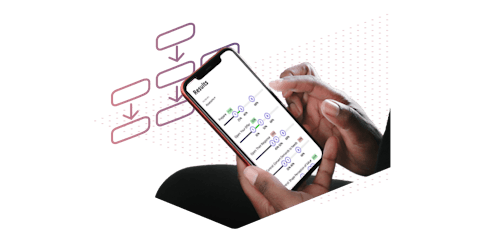7 Tips for Effective Sales Training Programmes
Sales performance improvement

Listing ingredients implies that they are part of a recipe, which of course can be literal or figurative. Without wasting time on prologues and previews, we know you’re hungry to learn about the 7 essential ingredients for building effective sales training programmes. The ingredients can be easily categorised according to their place in the sales training process:
- Pre-training: align methods with business strategy, build the right mindset, understand your customers
- Training: thoughtful design & facilitation, alignment with the sales process
- Post-training: technology for sustainment, ongoing internal promotion campaigns
What Makes Up Effective Sales Team Training? This blog post is adapted from an interview with Dario Priolo, former Chief Strategy Officer for Richardson Sales Performance and Michael Rochelle, Chief Strategy Officer for Brandon Hall Group. Part one our series of our on applying key practises in learning and development to effective sales training.
Pre Sales Training
1. Align sales training methods with your business strategy, goals and needs.Make sure your sales training objectives align with your overall business strategy. What is your corporate vision and how does the sales training help to support the organisation’s strategic objectives? At the end of the day, what is the behaviour that you are hoping to drive? How do you want your sales reps to change the way they do things? What do you want them to actually do in order to achieve the desired outcome?
If you can’t easily answer these questions or connect your sales training objectives to the needs and priorities of the company, then you should modify it or scratch it all together. Don’t waste precious time, effort and energy on tangential diversions. Instead, be able to connect the dots for the trainees, as well as senior management to keep everyone focused on the ultimate bottom line.
2. Have the right mindset.
Most training for sales teams is viewed, planned and executed as one-off events as opposed to part of a broader change management programme or continuous improvement process. Those who are willing to adopt a broader view of sales training programmes along a continuum – seeing the before, during and after of the training event – will have far greater success toward effective sales training.
If we’re thinking about the ingredients for a meal (training), take your sales training plan one step further: It’s not just about preparing one dish or meal, but rather about how to sustain that level of satisfaction until the next meal. Conversely, a one-and-done mindset is akin to fast food – it’s cheap and quick but unhealthy and no way to live.
3. Understand your customers.
In addition to knowing your business, you also need to consider what’s going on with your customers. There has been a tremendous shift in buyer behaviour in recent years fuelled by Internet searches, “showrooming,” tighter budgets, savvier buyers, mobile and social habits and the expectation of instant gratification and what-have-you-done-for-me-lately attitudes that can quickly trump customer loyalty. To combat these trends and obstacles, you need to understand why your customers buy what you sell, the value that you bring to them, and how they make buying decisions.
While you’re at it, consider other business or environmental changes that could factor into your sales training. Are there any new competitive forces or trends that could cause a shift? Once you’ve dispassionately evaluated these questions, then consider how your sales training programmes can help your sales teams circumvent or prevail over these issues.
During Sales Training
4. Great instructional design and facilitation makes for great learning.Relevance is critical. There is a premium on sales reps’ time, especially for coming out of the field for training. Therefore, make learning situational and, real-world based. Make it practical. Highly situational learners want to immediately apply what they’ve learnt. But if what they are learning does not seem immediately applicable, then they disengage. The training loses its impact, the messages are soon forgotten and learners retreat to their old habits.
Instructional designers and facilitators need to be keenly aware of what’s going on in the business and apply their knowledge to helping move the sales team towards their goals. Making sales training relevant is critical, but in addition to that, it must also be actionable. It is not just about transferring knowledge, but about helping sales reps to know what you’re asking them to do, why and how everyone (reps, company and customers) will benefit. Great instructional design and dynamic facilitation will help to bring that to life in the classroom and create that “just in time, just for me” feeling.
5. Build your sales training plan around your sales process.
Build on what you know works in your organisation. Think about those best practises that you might want to replicate across the organisation that relates to your training needs. Study people in your organisation who do it well, then incorporate other practises into your sales process training that will help sales reps execute against your strategic initiatives.
Many organisations have deep subject-matter experts in areas that could represent a considerable opportunity for the business. These subject-matter experts work with marketing teams to produce white papers or thought leadership pieces, but that content is not in a format that is easily digestible by sales.
The challenge is to unlock the subject matter expert’s knowledge and experience, package it and train your team to share these insights in customer conversations. It isn’t always obvious how and when those opportunities are going to present themselves, so having that scenario pre-programmed in the minds of your sales force so that it becomes very fluent and natural gives them an advantage. That requires mastery of the content, as well as the skills necessary to deliver that content in the customer conversations.
Create learning principles and takeaways that are highly relevant to real-world scenarios. An overall successful result on content development with a salesperson is, “Wow, I just faced that situation, and these concepts and tactics seem to fit perfectly. I took a lot away from what I have just absorbed through learning, and I will do a better job [or take a different approach] the next time I am faced with that situation.” Or “I can see where this could happen in my territory. I am glad to have had the opportunity to master the issue before I had to face it.”

Richardson Accelerate™ Sales Performance Platform
Accelerate provides a digital learning experience that uses assessments, video, gamification, and bite-sized modules to build sales competencies.
Learn MorePost Sales Training
6. Leverage technology.If technology can elevate the quality and efficacy of training environments, why not use it?
Just because you’ve always done things a certain way doesn’t mean you need to treat your training programmes with the same level of sophistication as a one-room schoolhouse on Little House on the Prairie.
We’ll cover this in greater detail in future posts, but here are two ways to use technology to make your training more effective:
- Have your instructors record their lessons in advance and share them with trainees before the training. That way the classroom time can be used for more practical skill-building, role plays and other exercises as opposed to listening to lectures.
- Keep the training alive by investing in a tool like QuickCheckTM to engage reps beyond the classroom and increase the odds that they’ll remember what they’ve been taught.
Ever important, yet always overlooked. If you’re trying to initiate a change, work with your in-house communications experts to craft a communications campaign to reinforce the messages and behaviours that you want to instill in your trainees. Use multiple channels over time to “drip” the message (e.g., email, break room posters, webinar presentations, internal social networking groups, lunch and learns). Finally, identify ways to measure the impact and effectiveness of the training, and make adjustments to your next training initiative if necessary.
Does this list of essential ingredients resonate with you? What else would you add to ensure successful and effective sales training initiatives? Tell us in the Comments section.

Brief: Optimising Sales Training Outcomes
DownloadGet industry insights and stay up to date, subscribe to our newsletter.
Joining our community gives you access to weekly thought leadership to help guide your planning for a training initiative, inform your sales strategy, and most importantly, improve your team's performance.






